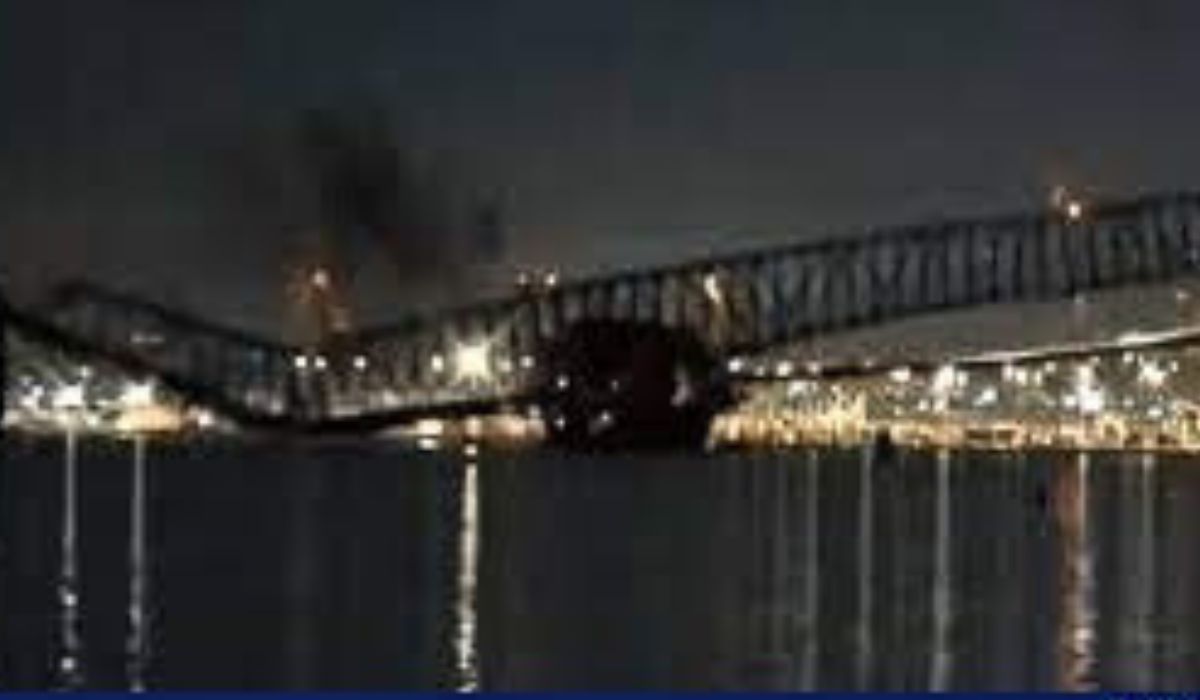National
Catastrophic Collapse: Francis Scott Key Bridge Partially Destroyed After Cargo Ship Collision

Baltimore, MD – In a catastrophic incident that has sent shockwaves through the region, the Francis Scott Key Bridge, a vital maritime artery for the East Coast, partially collapsed early Tuesday morning after being struck by a massive cargo ship. The devastating collision has prompted a massive emergency response, with rescue efforts currently underway to locate at least seven individuals who were reportedly in the water following the bridge’s collapse.
The Harrowing Incident
The chaotic scene unfolded around 1:30 a.m. when the Baltimore City Fire Department received multiple 911 calls reporting that a vessel had struck the Francis Scott Key Bridge, causing a section of the bridge to crumble into the waters below. Kevin Cartwright, director of communications for the Baltimore Fire Department, confirmed the gravity of the situation to Reuters, stating, “We received several 911 calls at around 1:30 a.m., that a vessel struck the Key Bridge in Baltimore, causing the collapse. This is currently a mass casualty incident, and we are searching for seven people who are in the river.”
The Associated Press further reported that several vehicles had plunged into the Patapsco River beneath the bridge, and the cargo ship involved in the collision had caught fire. “This is a dire emergency,” Cartwright told the AP. “Our focus right now is trying to rescue and recover these people.”
Massive Emergency Response
In response to the catastrophic incident, a massive emergency response has been mobilized, with multiple agencies converging on the scene to assist in rescue and recovery efforts. Brendon Scott, the Mayor of Baltimore, acknowledged the unfolding crisis on social media, stating, “I am aware of the incident involving the Francis Scott Key Bridge, and I am en route to the scene. Emergency personnel are on site, and efforts are underway.”
The vessel involved in the collision has been identified as the Singapore-flagged container ship Dali, according to ship tracking data from LSEG. Reuters, citing the same data, reported that the registered owner of the ship is Grace Ocean Pte Ltd., and it is managed by Synergy Marine Group. Synergy Marine Corp confirmed that the Dali had collided with one of the bridge’s pillars, adding that all crew members, including two pilots, have been accounted for, and there were no reports of injuries among the crew.
Critical Maritime Artery
The Francis Scott Key Bridge, named after the author of the “Star Spangled Banner,” is a 1.6-mile, four-lane bridge that spans the Patapsco River, serving as a critical link for maritime traffic in the Baltimore region. Opened in 1977, the bridge has become an integral part of the region’s transportation infrastructure, facilitating the movement of goods and people alike.
The bridge’s importance cannot be overstated, as the Port of Baltimore, which it serves, is a vital economic engine for the region and the entire East Coast. In 2023 alone, the port’s private and public terminals handled a staggering 847,158 automobiles and light trucks, the highest volume of any U.S. port. Additionally, the port plays a crucial role in the movement of various commodities, including farm and construction machinery, sugar, gypsum, and coal, according to the Maryland government website.
Widespread Disruptions
The catastrophic collapse of a portion of the Francis Scott Key Bridge has already begun to ripple through the region’s transportation network, with the Maryland Transportation Authority (MDTA) announcing the closure of all lanes in both directions on the bridge early Tuesday morning. “All lanes closed in both directions for the incident on I-695 Key Bridge,” the MDTA stated on social media. “Traffic is being detoured.”
The impact of this disruption is likely to be far-reaching, affecting not only the flow of vehicular traffic but also the movement of maritime cargo through the Port of Baltimore. As rescue and recovery efforts continue, officials will undoubtedly be working tirelessly to assess the extent of the damage and develop contingency plans to mitigate the economic and logistical consequences of this catastrophic event.
A Night of Terror and Uncertainty
As the sun rises over Baltimore, the city finds itself grappling with the aftermath of a night marred by terror and uncertainty. The collapse of a portion of the Francis Scott Key Bridge has left a gaping wound in the region’s transportation infrastructure, disrupting vital maritime and ground operations.
While the full extent of the damage and the human toll remains unclear, the priority for emergency responders remains the ongoing search and rescue efforts for the seven individuals believed to have been in the water at the time of the collapse. Their fate hangs in the balance, as rescue teams work tirelessly to locate and extract them from the treacherous waters of the Patapsco River.
As the investigation into the cause of this catastrophic incident unfolds, questions will undoubtedly be raised about the safety protocols and measures in place to prevent such collisions from occurring in the first place. The Francis Scott Key Bridge, a crucial artery for the region’s maritime commerce, now stands as a symbol of the fragility of our infrastructure and the need for constant vigilance and maintenance.
In the coming days and weeks, the focus will shift to assessing the damage, developing contingency plans, and ultimately, rebuilding and restoring the vital link that the Francis Scott Key Bridge represents. This incident serves as a stark reminder of the interconnectedness of our transportation systems and the far-reaching consequences that can arise from a single point of failure.
As the people of Baltimore and the surrounding communities come together to support those affected by this tragedy, the resilience and determination of the region will be tested. But in the face of adversity, the spirit of unity and perseverance that has defined this city will undoubtedly shine through, guiding the path toward recovery and a stronger, more resilient future.
